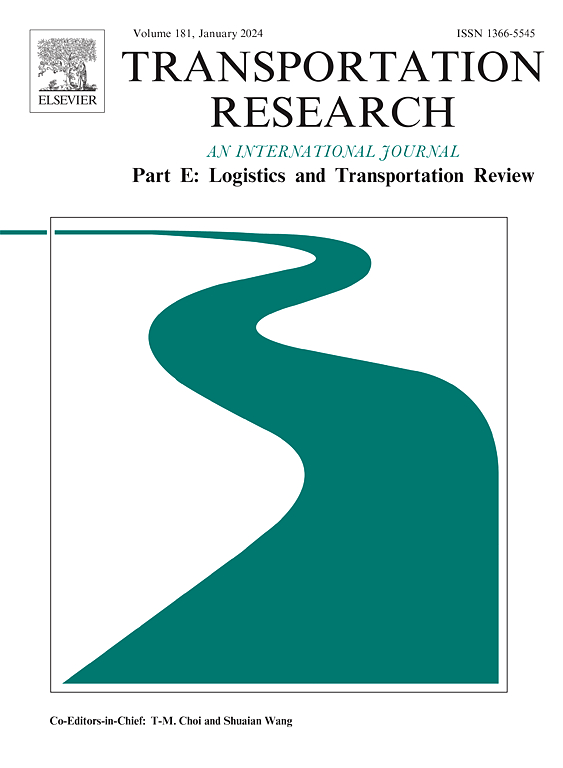Dose free brand spillover always benefit? Procurement outsourcing in co-opetitive supply chains
IF 8.3
1区 工程技术
Q1 ECONOMICS
Transportation Research Part E-Logistics and Transportation Review
Pub Date : 2025-03-07
DOI:10.1016/j.tre.2025.104014
引用次数: 0
Abstract
When many original brand manufacturers (OBMs) have outsourced their manufacturing/procurement functions to competitive contract manufacturers (CMs), CMs may advertise this relationship to promote their private brand products. Faced with such brand spillover, OBMs start to restructure their outsourcing arrangements. This paper investigates the impact of brand spillover on OBMs’ outsourcing choices and whether CMs should utilize brand spillover. We construct a three-tier co-opetitive supply chain consisting of an OBM, a CM, and a material supplier. The CM who directly sells his private brand products also takes charge of procurement and manufacturing functions of the OBM’s original brand products. With such a relationship, the CM determines whether or not to commit to implementing free brand spillover. Thereafter, the OBM can decide to proceed with outsourcing her material procurement function to the competitive CM (i.e., procurement outsourcing) or switch to independently procure materials (i.e., independent procurement). Results reveal that when the CM’s initial brand power is small, the OBM chooses procurement outsourcing; otherwise, she switches to independent procurement. Interestingly, the OBM’s choice of independent procurement can benefit all the firms. Brand spillover discourages the OBM from outsourcing her procurement to the CM because it allows the CM to focus more on his private brand business and thus causes the OBM a considerably high cost to work with the CM. Although brand spillover improves the CM’s initial brand power at no cost, the CM may make a commitment by not taking free brand spillover when considering the OBM’s shift towards independent procurement. Our findings suggest that CMs with private brand should be cautious in adopting free brand spillover as a marketing tool.
免费品牌的溢出效应总是有益的吗?合作竞争供应链中的采购外包
当许多原始品牌制造商(obm)将其制造/采购职能外包给有竞争力的合同制造商(CMs)时,CMs可能会宣传这种关系,以推广其自有品牌产品。面对这种品牌溢出效应,obm开始调整其外包安排。本文研究了品牌溢出对外包企业选择的影响,以及外包企业是否应该利用品牌溢出。我们构建了一个由OBM、CM和材料供应商组成的三层合作竞争供应链。直接销售自有品牌产品的CM同时负责OBM原品牌产品的采购和制造职能。在这种关系下,CM决定是否承诺实施自由品牌溢出。之后,OBM可以决定将其材料采购功能外包给竞争CM(即采购外包),或者切换到独立采购材料(即独立采购)。结果表明,当采购经理初始品牌力较小时,采购经理会选择采购外包;否则,她就转向独立采购。有趣的是,OBM选择独立采购可以使所有公司受益。品牌溢出会阻碍OBM将采购外包给CM,因为这会让CM更专注于自己的自有品牌业务,从而导致OBM与CM合作的成本相当高。虽然品牌溢出可以无偿地提高战略经理的初始品牌力,但在考虑战略经理向自主采购转变时,战略经理可能会做出不采取免费品牌溢出的承诺。我们的研究结果表明,拥有自有品牌的CMs应谨慎采用免费品牌溢出作为营销工具。
本文章由计算机程序翻译,如有差异,请以英文原文为准。
求助全文
约1分钟内获得全文
求助全文
来源期刊
CiteScore
16.20
自引率
16.00%
发文量
285
审稿时长
62 days
期刊介绍:
Transportation Research Part E: Logistics and Transportation Review is a reputable journal that publishes high-quality articles covering a wide range of topics in the field of logistics and transportation research. The journal welcomes submissions on various subjects, including transport economics, transport infrastructure and investment appraisal, evaluation of public policies related to transportation, empirical and analytical studies of logistics management practices and performance, logistics and operations models, and logistics and supply chain management.
Part E aims to provide informative and well-researched articles that contribute to the understanding and advancement of the field. The content of the journal is complementary to other prestigious journals in transportation research, such as Transportation Research Part A: Policy and Practice, Part B: Methodological, Part C: Emerging Technologies, Part D: Transport and Environment, and Part F: Traffic Psychology and Behaviour. Together, these journals form a comprehensive and cohesive reference for current research in transportation science.

 求助内容:
求助内容: 应助结果提醒方式:
应助结果提醒方式:


